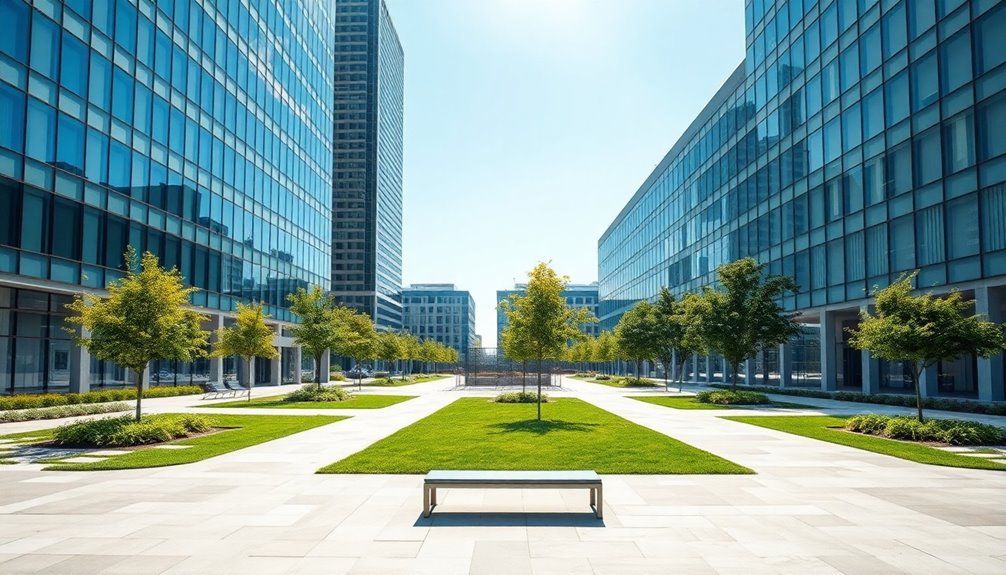Minimalism in modern urban design prioritizes simplicity and functionality, helping you navigate spaces with ease. By reducing clutter and maximizing open areas, it enhances your quality of life and encourages community interaction. Additionally, minimalist environments support sustainability through eco-friendly materials and efficient resource usage. This thoughtful approach not only lowers stress but also fosters a deeper connection with nature. Discover how these principles shape successful urban projects and the future of city planning.
Key Takeaways
- Minimalism in urban design promotes simplicity and functionality, enhancing the quality of life through reduced clutter and maximized open spaces.
- It fosters sustainability by utilizing eco-friendly materials and energy-efficient systems, lowering resource consumption and environmental impact.
- Minimalist public spaces encourage community engagement and social interaction by integrating green areas and pedestrian-friendly pathways.
- The design reduces sensory overload, which enhances user experience, lowers stress, and improves emotional well-being in urban environments.
- Successful minimalist projects, like New York's High Line, demonstrate the potential for transforming urban landscapes into efficient, multifunctional spaces.
Understanding Minimalism in Urban Design

While many urban environments are cluttered with unnecessary structures and distractions, minimalism in urban design offers a revitalizing alternative that prioritizes simplicity and functionality. This design philosophy reduces clutter, maximizing open spaces to enhance your quality of life.
By promoting natural materials and efficient layouts, minimalism supports sustainability, minimizing resource consumption and environmental impact. You'll find that minimalist urban environments often feature green spaces, pedestrian-friendly pathways, and multi-functional public areas, all fostering community engagement and social interaction.
The principles of minimalism encourage a thoughtful integration of architecture with nature, creating harmonious living spaces that prioritize your well-being and mental clarity. As urban congestion rises, embracing minimalist design becomes a practical choice for accessible and aesthetically pleasing public areas.
The Impact of Minimalism on Public Spaces
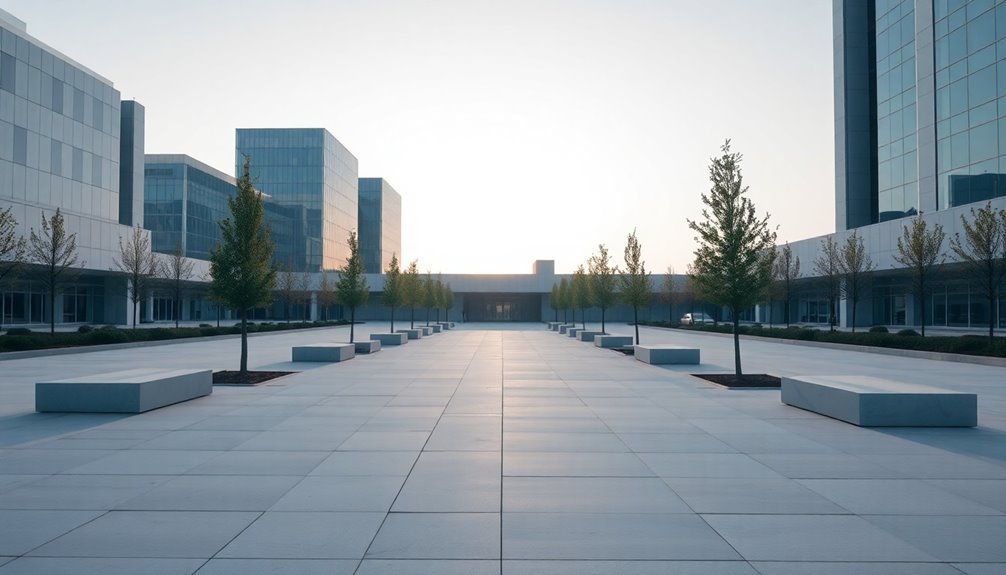
Minimalism in urban design has a profound impact on public spaces, reshaping how individuals interact with their surroundings. By emphasizing simplicity and essential elements, minimalist design fosters functionality and reduces sensory overload. You'll find that these uncluttered spaces promote relaxation and enhance community engagement, creating environments that encourage social interactions. Additionally, the principles of sustainable building practices are often integrated into minimalist urban designs, contributing to more environmentally friendly public spaces.
| Feature | Minimalist Design |
|---|---|
| Aesthetics | Clean lines, natural materials |
| Community Engagement | Increased social interactions |
| Mental Well-being | Relaxation and improved flow |
| Sustainability | Resource efficiency and reduced waste |
Incorporating natural light and materials fosters harmony between built environments and nature, aligning with a contemporary design philosophy that prioritizes both aesthetics and functionality.
Enhancing User Experience Through Simplicity
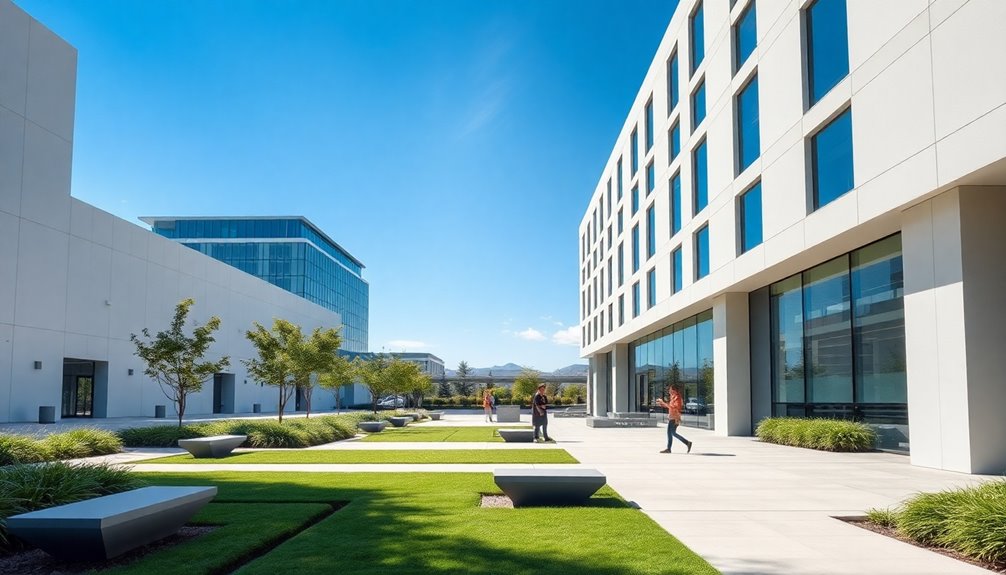
When you navigate through urban spaces, a streamlined design can make all the difference.
Clutter-free environments not only reduce distractions but also create a more inviting atmosphere for everyone.
Streamlined Navigation Design
As urban environments become increasingly complex, streamlined navigation design plays a crucial role in enhancing user experience through simplicity.
By embracing minimalist design, you can navigate urban spaces with ease. Clean lines and clear typography in signage improve visibility and comprehension, boosting navigational efficiency by 50%. This simplicity reduces cognitive load, making wayfinding intuitive and efficient.
Incorporating open spaces and minimal clutter fosters unobstructed sightlines, enhancing safety and comfort for pedestrians and cyclists. Additionally, utilizing digital technology, like mobile apps and interactive kiosks, provides straightforward, on-demand information that aligns with minimalist principles. Moreover, the use of energy efficiency in urban design can complement minimalist concepts by promoting sustainable practices.
Research shows that environments designed with streamlined navigation lead to a 30% reduction in user frustration, ultimately increasing overall satisfaction with public spaces.
Clutter-Free Environments
Streamlined navigation design sets the stage for clutter-free environments, where simplicity reigns supreme.
In modern architecture, minimalist designs emphasize simplicity, promoting mental clarity and reducing stress. You'll find that open floor plans and minimal furnishings create a more inviting atmosphere, enhancing user experience in urban design.
Natural materials and ample light foster a harmonious connection between you and your surroundings, boosting overall satisfaction.
Additionally, these clutter-free environments encourage social interactions and community engagement, offering flexible spaces for various activities.
The aesthetic appeal of clean lines draws more visitors, ultimately enhancing the quality of urban life. Moreover, incorporating lighting design can further elevate the ambiance of these spaces, ensuring an even more enjoyable experience for users.
Sustainability and Resource Efficiency in Minimalist Design
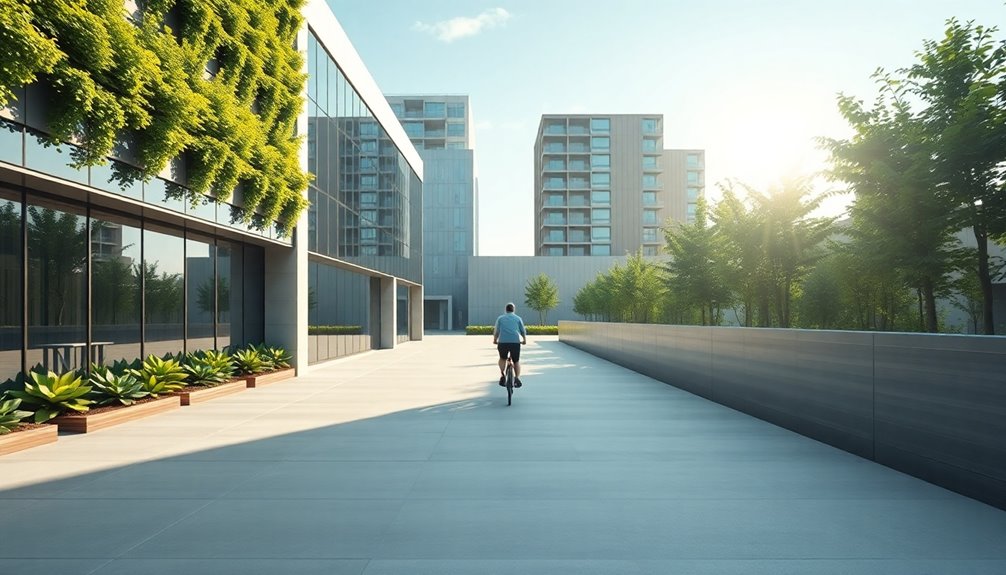
Emphasizing sustainability in minimalist design not only fosters a more eco-friendly urban environment but also encourages mindful consumption. By utilizing durable, eco-friendly materials, you reduce the need for frequent replacements and minimize resource consumption. Open spaces in minimalist settings enhance energy efficiency, requiring less lighting and heating. Multi-purpose furniture cuts down on additional items, lowering waste generation. In addition, natural light and ventilation reduce reliance on artificial systems, leading to significant energy savings. Furthermore, implementing energy-efficient systems can contribute to a decrease in overall energy demand.
| Aspect | Benefits | Impact on Sustainability |
|---|---|---|
| Eco-friendly Materials | Reduces waste and resource use | Promotes longevity |
| Open Spaces | Enhances energy efficiency | Lowers energy consumption |
| Multi-purpose Furniture | Minimizes clutter and waste | Encourages resource efficiency |
| Natural Light | Decreases reliance on artificial lighting | Supports energy savings |
| Mindful Consumption | Reduces overconsumption | Aligns with sustainable practices |
Psychological Benefits of Minimalist Environments
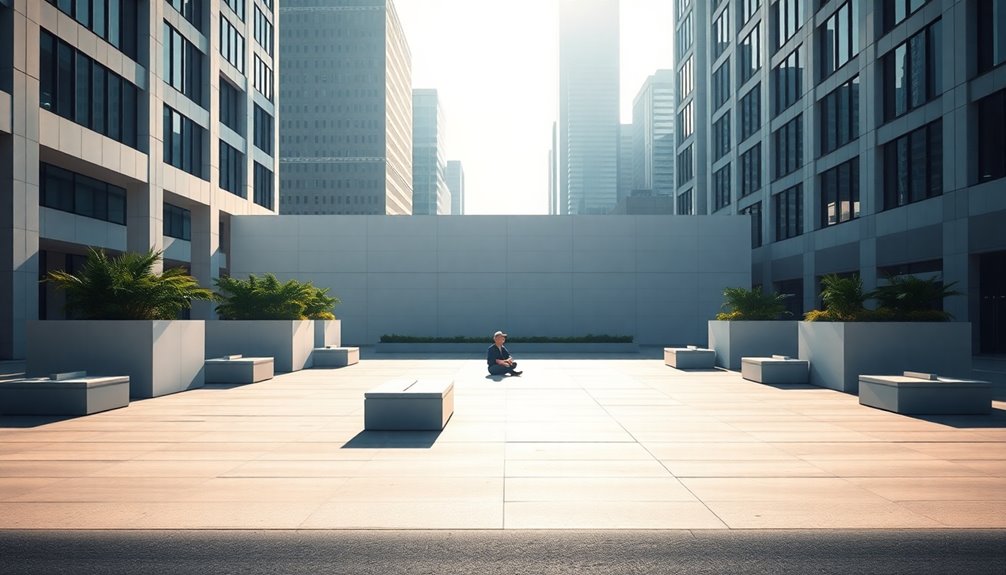
In a minimalist environment, you'll notice a significant reduction in stress levels as clutter fades away.
This simplicity enhances your focus and clarity, allowing you to tackle tasks with greater ease.
Ultimately, these elements contribute to improved emotional well-being, making urban living more enjoyable.
Reduced Stress Levels
Clarity is essential for mental well-being, and minimalist environments provide just that. By embracing reduced clutter, you create a space that fosters mental clarity and a sense of calm.
Studies show that individuals in minimalist-designed spaces experience lower anxiety levels and improved emotional health compared to those surrounded by chaos. The simplicity of these environments reduces sensory overload, allowing your mind to breathe and focus better.
Natural materials and ample light enhance your mood, contributing to a more positive psychological state. Engaging with minimalist surroundings encourages mindfulness and intentional living, which are key to reducing stress.
Ultimately, a minimalist approach to design can lead to a more serene lifestyle, helping you maintain balance and well-being in an increasingly complex world.
Enhanced Focus and Clarity
Minimalist environments not only reduce stress but also greatly enhance your focus and clarity. By embracing minimalism in architecture, you create uncluttered spaces that eliminate distractions, promoting a sense of calm.
This simplicity fosters enhanced focus, allowing you to concentrate better on tasks at hand. Research shows that when you work in open, functional environments, your cognitive abilities improve, leading to increased productivity in both work and leisure.
The intentional design of minimalist spaces encourages you to prioritize meaningful experiences over material possessions, which can boost your emotional resilience.
Ultimately, a minimalist approach helps you regain control over your surroundings, resulting in a clearer mind and a more satisfying life.
Improved Emotional Well-being
As you embrace minimalist environments, you may find that your emotional well-being greatly improves.
Minimalism often reduces stress by promoting uncluttered spaces, leading to lower anxiety levels and enhanced mental clarity. When you incorporate natural light, the positive effects on your mood and overall psychological well-being become even more pronounced.
These serene surroundings foster a sense of purpose and encourage mindful, intentional living. As you simplify your space, you may notice greater life satisfaction and emotional resilience.
Research shows that individuals in minimalist settings report higher happiness and contentment, highlighting the psychological benefits of intentional consumption and reduced materialism. Additionally, engaging in nature nurtures inner calm and connection, further supporting emotional well-being.
Case Studies: Successful Minimalist Urban Projects
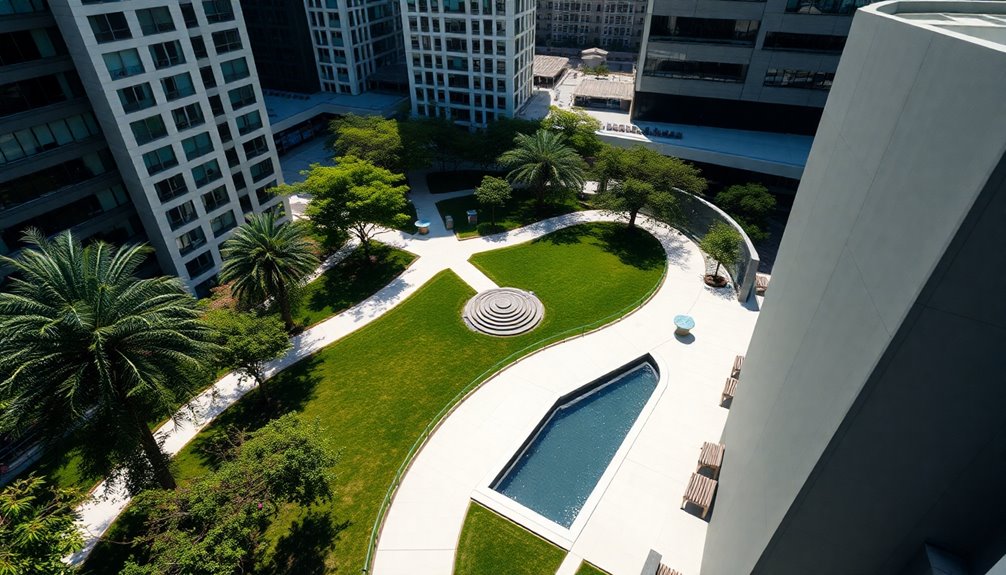
While urban spaces often feel congested and chaotic, several successful projects demonstrate how minimalist principles can transform these environments into inviting and functional areas.
The High Line in New York City, for instance, turned an abandoned railway into a lush linear park, emphasizing open space and fostering community engagement.
In Miami Beach, 1111 Lincoln Road cleverly merges retail, parking, and public space through minimalist architecture, enhancing functionality.
Meanwhile, Milan's Bosco Verticale integrates vertical gardens into residential buildings, promoting sustainability and biodiversity.
Kramarczuk's Market in Minneapolis showcases open layouts that encourage seamless interactions, while One Central Park in Sydney features dual towers with horizontal gardens, creating harmony between urban living and nature.
These projects exemplify the power of minimalism in urban design.
Challenges in Implementing Minimalist Principles
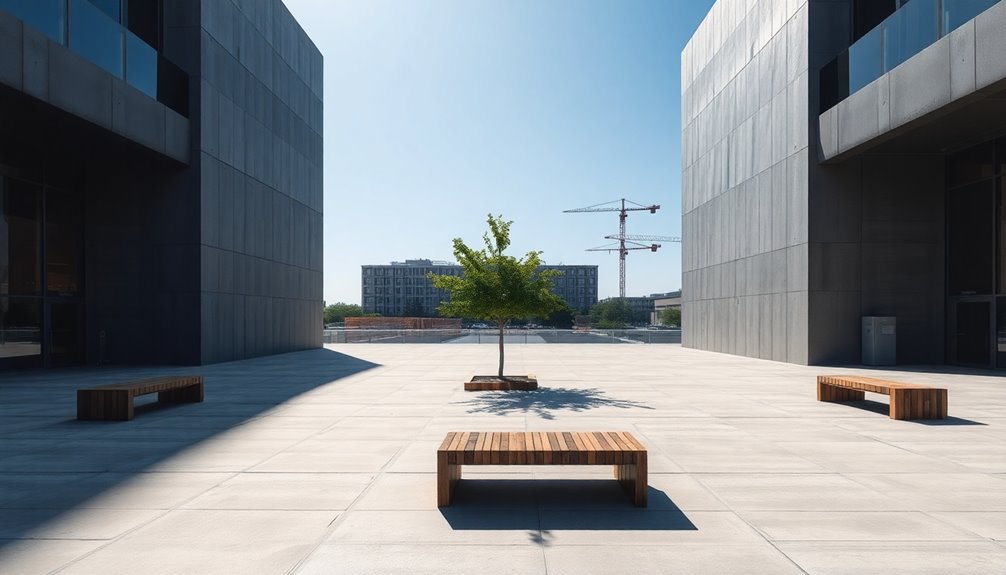
Implementing minimalist principles in urban design often encounters significant challenges that can hinder progress. You may face resistance from stakeholders who prefer traditional architectural styles, making it tough to promote minimalism.
Implementing minimalist principles in urban design faces challenges, including resistance to simplicity from stakeholders favoring traditional styles.
Additionally, balancing functionality with minimalist ideals can lead to overcrowding, as multi-functional needs clash with the desire for open spaces. Budget constraints also play a role, as high-quality materials needed for minimalist designs may seem costly compared to conventional options.
Here are three key challenges:
- Cultural resistance: Stakeholders may prioritize complex designs over simplicity.
- Zoning regulations: Existing codes mightn't support minimalist layouts.
- Sustainability demands: Efficient resource use can complicate minimalist aesthetics.
Navigating these hurdles is vital for effective urban design. Moreover, embracing mindful art of decluttering can help create spaces that align with minimalist principles while promoting a sense of calm and order.
The Future of Minimalism in Urban Planning
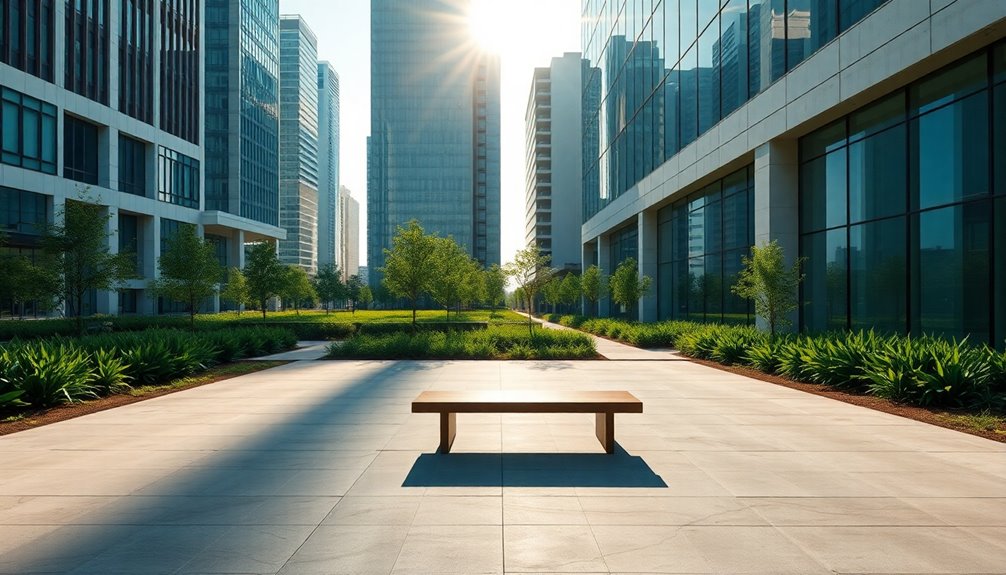
Steering through the challenges of minimalist principles in urban design opens up exciting possibilities for the future of urban planning.
As you embrace minimalism in design, you'll find that open floor concepts and multifunctional spaces can enhance urban living. The push for sustainable living solutions drives the integration of eco-friendly materials and resource-efficient practices in public spaces.
Future urban planning will likely showcase innovative design elements that prioritize simplicity and functionality, reducing sensory overload while fostering community engagement.
By focusing on these minimalist principles, you can help create resilient urban landscapes that not only address overpopulation but also elevate the quality of life.
Embracing this shift guarantees cities become more aesthetically pleasing and livable for everyone.
Frequently Asked Questions
What Is Minimalism in Modern Architecture?
Minimalism in modern architecture emphasizes simplicity and functionality.
You'll notice clean lines, geometric shapes, and an uncluttered aesthetic that creates a sense of calm. The philosophy of "less is more" drives you to eliminate unnecessary elements, enhancing the space's overall purpose.
You'll find that materials like concrete and glass are favored for their durability and beauty. Open floor plans promote flow, valuing negative space as an essential part of the design.
What Is the Significance of Minimalist Design?
Imagine stepping into a serene oasis where chaos melts away.
Minimalist design's significance lies in its ability to strip away the unnecessary, allowing you to focus on what truly matters. It fosters clarity and calm, enhancing your daily experience.
By prioritizing functionality and sustainability, it not only beautifies your surroundings but also nurtures your well-being.
In a world filled with noise, minimalist design offers a rejuvenating breath of simplicity, transforming spaces into peaceful retreats.
What Is Urban Minimalism?
Urban minimalism is all about creating spaces that emphasize simplicity and functionality.
You'll notice clean lines, open areas, and a focus on essential elements that enhance both beauty and usability. This approach reduces clutter and sensory overload, promoting a sense of calm in bustling city life.
With an emphasis on natural light, sustainable materials, and adaptable spaces, urban minimalism aims to foster community interaction while addressing modern environmental concerns.
Is Minimalism Part of Modernism?
When you get down to brass tacks, minimalism is indeed a part of modernism. It emphasizes simplicity and functionality, aligning perfectly with the modernist mantra of "form follows function."
You'll notice that key figures in modern architecture, like Mies van der Rohe and Le Corbusier, championed clean lines and open spaces. This minimalist approach not only enhances aesthetic appeal but also promotes a harmonious relationship between structures and their surroundings.
Conclusion
In a world bustling with excess, embracing minimalism in urban design feels like a refreshing change—if that change isn't smoggy, of course. By stripping away the clutter, you've got public spaces that invite connection, sustainability that practically begs for attention, and psychological benefits that might just lead to fewer existential crises. So, as you forge ahead into this minimalist future, remember: less really can be more—unless you're talking about coffee shops, then keep 'em coming!
